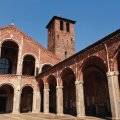BASILICA OF SANT'AMBROGIO
A marvellous example of Romanesque art, this basilica is as powerful as it is harmonious and contains precious decorations and a rich treasure.
A testimony to 16 centuries of history and considered one of the most famous examples of Lombard Romanesque art, Sant'Ambrogio is the main Milanese basilica dedicated to the patron saint of the city. Built from 379 by St. Ambrose, bishop of Milan, in order to deposit the bodies of the two martyrs Gervais and Protais, it will be completed much later. It will be destroyed and rebuilt many times, in particular in the 12th century and following the bombings of the Second World War. A magnificent atrium with finely carved capitals precedes the body of the building; on the façade, a bronze portal from the 18th century still displays some beautiful leaves from the 9th century.
Inside, there is a unique example of a 12th-century ambo (pulpit for the reading of sacred texts), decorated with two rare gilded copper sculptures, an eagle (symbol of St John) and an angel (symbol of St Matthew), which makes the structure unique in its kind. The ambo rests on a sarcophagus from the 1st century AD, the walls of which are entirely decorated with bas-reliefs. The gold and precious stone high altar, carved by Vuolvinius (9th century), is a fine example of medieval goldsmithing. Above it rises a ciborium with a baldachin supported by four antique columns of red porphyry. The chapel of San Vittore in Ciel d'Oro is a remarkable example of a previous early Christian building. It was commissioned at the beginning of the5th century to house the remains of the martyr Vittore. It was incorporated into the Basilica in the 15th century and has a beautifully crafted mosaic decoration; the portrait of San Vittore is in the centre of the dome, surrounded by a garland of ears of corn and flowers, while on the walls there are several effigies of saints and bishops, including Ambrose. The crypt preserves the remains of the three saints under a 19th century glass case. There is also a small museum of the Treasury where you can admire a beautiful collection of liturgical pieces from the basilica. At the end of the nave, on the left, an exit gives access to the harmonious portico of Bramante and to the small Romanesque chapel of San Sigismondo. Curiosity, in the square of the church, there is a strange white marble column with two small holes, known as the "devil's column". It is said that the devil, desperate not to have succeeded in dragging Saint Ambrose into sin, would have blown his horn into the column...
Did you know? This review was written by our professional authors.
Book the Best Activities with Get Your Guide
Members' reviews on BASILICA OF SANT'AMBROGIO
The ratings and reviews below reflect the subjective opinions of members and not the opinion of The Little Witty.
Find unique Stay Offers with our Partners






The church is preceded by a large quadriportico, overlooked by the gabled façade, with two levels of arches, and the two bell towers, that of the Monks and that of the Canons. Under the portico is the treasure of Sant'Ambrogio, which includes goldsmith's objects, fabrics, tapestries, marble, stucco, mosaics, wooden fragments and paintings. Pause in front of the so-called " Devil's Column ", which owes its name to the legend according to which the devil, fighting with Saint Ambrose, stuck his horns right into the column, on which two side-by-side holes are still visible today.
Inside the church, along the left nave, in the first chapel there is a valuable fresco by Bergognone, the risen Christ and angels. In the lower apse, however, you can admire the crypt in which the bodies of saints Ambrose, Gervasio and Protasio are preserved.
The basilica is accessible to disabled people and often hosts groups and schools, as long as the visits are conducted by private guides. Inside the architectural complex you will also find a small museum and a bookshop.